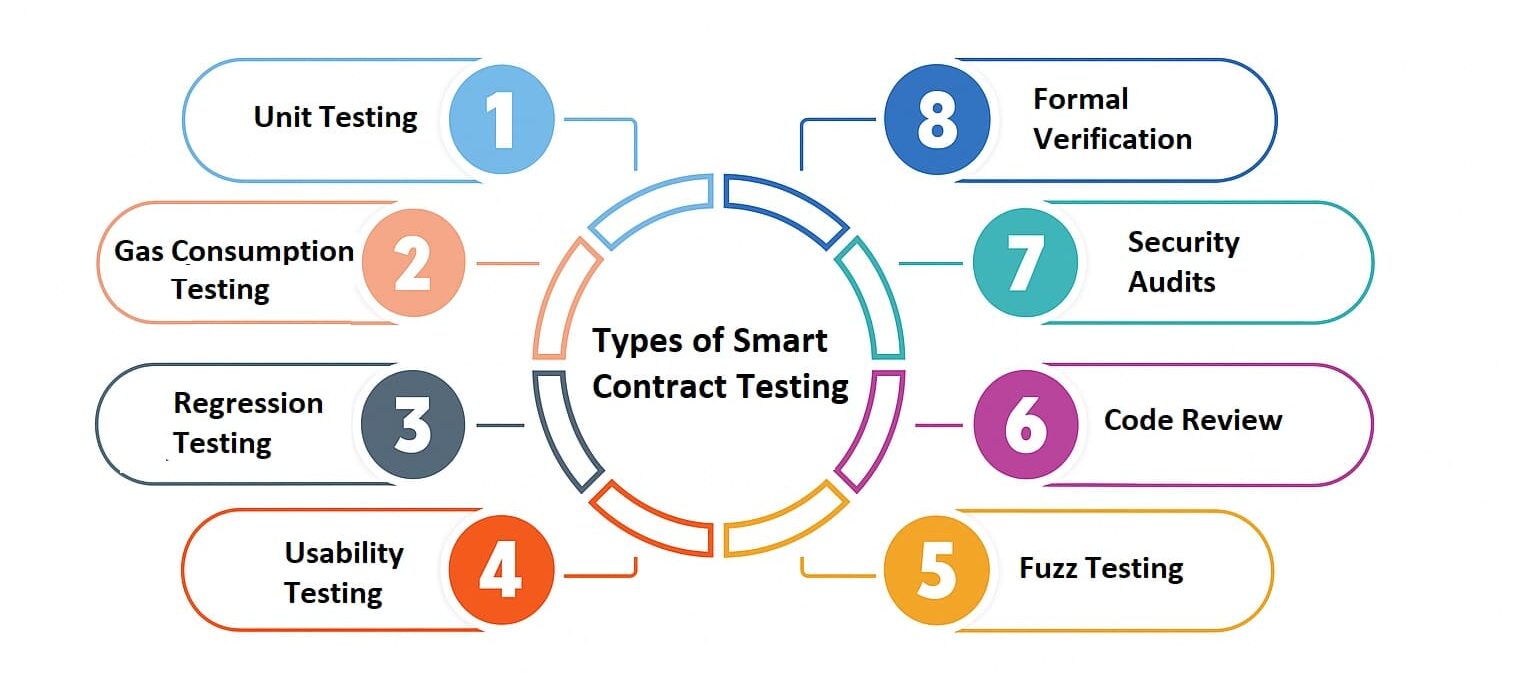Smart Contract Testing: Ensuring Quality in Blockchain Applications

The Web3 internet represents the next phase of digital evolution, characterized by a shift from centralized platforms to decentralized blockchain technology. Unlike Web2, where corporations control user data and transactions, Web3 leverages distributed ledger technology to enable user ownership. One of the technologies that supports Web3 is blockchain. It is a chain of blocks, a decentralized, distributed ledger technology to ensure security and transparency. They are mainly used for financial transactions.
Blockchain includes various components. A smart contract is one of the components. Smart contracts are self-executing programs on the blockchain that manage transactions and enforce business logic.
In traditional applications, errors are often corrected with an update. But a single coding flaw in a smart contract can result in severe security breaches and financial losses. So, smart contract testing is critical. It is the process of verifying whether the code of a smart contract functions as expected. Testing is useful for identifying vulnerabilities, such as unauthorized access. Additionally, testing optimizes gas consumption, particularly for networks like Ethereum, where inefficient code can result in high transaction fees.
Types of Smart Contract Testing

1. Unit Testing
Unit testing is the process of examining specific functions in a smart contract to make sure they work as intended. It is one of the types of testing that helps locate and resolve faults in particular sections of the code.
2. Gas Consumption Testing
Gas consumption testing determines how much gas or processing power is required to carry out certain smart contract operations. The primary intent of this testing is to ensure transaction profitability and optimize the code for the blockchain platform.
3. Regression Testing
Regression testing ensures that upgrades and changes to the smart contract don’t break existing functionalities or produce new bugs. It contributes to keeping the smart contract reliable as it evolves.
4. Usability Testing
Usability testing ensures whether users can interact with the smart contract without unnecessary complications. It takes into account factors like interaction ease and user interface clarity.
5. Fuzz Testing
Fuzz testing involves inputting unexpected or random data into a smart contract to identify and detect unpredictable behavior. This testing helps to find potential bugs and vulnerabilities.
6. Code Review
Code review is the process by which expert developers manually or automatically review the smart contract code. It ensures adherence to coding standards to identify possible problems and improve the quality of the code.
7. Security Audits
Security issues identified in audits are exploiting external calls to withdraw funds repeatedly before the completion of the initial transaction, and errors in numerical calculations leading to unintended contract behavior. Security audits ensure that the smart contract is resilient to issues, aiding in the prevention of security breaches.
8. Formal Verification
Formal verification is to mathematically prove that a smart contract behaves as expected under every condition. It is complex, but formal verification is valuable for high-value blockchain applications.
Challenges in Testing Smart Contracts
- Once deployed, smart contract code is immutable, making errors permanent and vulnerable to exploitation.
- Smart contracts often work with other contracts, data sources, and blockchain platforms. Testing these interactions can be hard, especially with cross-contract function calls.
- Smart contracts consume gas, so optimizing their usage requires a deep understanding of the code and thorough testing. It adds complexity to the process.
- Calling external contracts before state updates makes smart contracts vulnerable to reentrancy attacks, enabling repeated withdrawals or malicious code.
- Logic errors occur when smart contracts contain code that diverges from desired behavior. Depending on the error, it can cause disrupted functionality.
- A Denial of Service (DoS) attack can render smart contracts unusable, trigger financial losses, and damage the platform reputation.
Why is Smart Contract Testing necessary?
Smart contracts control millions of dollars in digital assets, making them prime targets for hackers. So, testing them is necessary as follows:
Avoid security breaches: The Wormhole hack in 2022 was because the developers’ use of a single, deprecated function. This hack enabled a forged signature pass without verification. But testing prevented this hack.
Prevent irreversible losses: Smart contracts power Decentralized finance (DeFi), NFTs, and enterprise blockchain solutions. Any fault in the contract logic can lead to financial losses and operational failures. So, thorough testing ensures that smart contracts function as intended under various conditions.
Reduce costs: Inefficient contract code results in huge transaction costs, making apps expensive to use. As such, testing helps to optimize code inefficiencies, reduce gas consumption, and improve transaction speed.
Build trust and credibility: Investors, users, and businesses are more likely to engage with a platform that prioritizes security. Hence, testing smart contracts boosts credibility and helps your company comply with changing regulatory standards.
Best Practices for Smart Contract Testing
Testing is a vital phase in smart contract development where you ensure that your code performs as intended and adheres to the highest security standards and reliability. So, adopting the best practices below in testing smart contracts can reduce risks and ensure that your contracts perform as intended across various scenarios:
- Measuring code coverage percentage ensures adequate test coverage for your smart contract and helps identify potential vulnerabilities early in development.
- Performing tests on scenarios like zero values, maximum limits, or invalid inputs would ensure comprehensive test coverage for the smart contract.
- Using descriptive names and avoiding redundant tests can maintain effective test coverage for a smart contract.
Effective smart contract testing demands a precise methodology and the application of the above practices. By maintaining descriptive test names, comprehensive scenario coverage, and adequate code coverage measurement, developers can significantly reduce security risks and enhance contract reliability.
Role of AI in Smart Contract Testing
Artificial intelligence (AI) is enhancing the adaptability of smart contracts. Using machine learning (ML) models, smart contracts can dynamically optimize gas usage, find vulnerabilities, and even trigger autonomous upgrades. AI is also assisting in translating legal documents into logical language, thereby bridging the human-machine gap. This convergence enables the creation of smart contracts that evolve, self-regulate, and rectify logical flaws.
The AI’s most widespread application in smart contracts revolves around assisting engineers in creating, testing, and maintaining smart contracts. One such example is Etherscan, a popular tool for blockchain scanning on Ethereum, which has introduced an AI-powered tool to help users better understand the terms of smart contracts.
AI models can identify potential security flaws in the smart contract code by detecting unusual deviations from the expected workflows in real-time. Currently, AI research and development company ChainML is collaborating with Cube3, a real-time fraud prevention platform, to develop an ML model for the real-time identification of fraudulent crypto transactions, thereby catching hackers off guard.
👉 Want to explore this topic in depth? Download our Whitepaper on AI in Testing to discover how AI is transforming software quality and smart contract reliability.
Conclusion
In smart contract development, testing isn’t optional; it is essential. Unlike traditional software, smart contracts are immutable once deployed, meaning a single vulnerability can result in irreversible financial losses.
The challenges of smart contract development, like gas optimization and reentrancy attacks, make comprehensive blockchain smart contract testing the only way to secure applications. With AI and machine learning now enhancing testing capabilities, developers can use tools to detect vulnerabilities before deployment.
Ready to improve testing of the smart contracts? Explore the following testing frameworks and tools:
- Hardhat: It is a modern development environment with comprehensive testing capabilities.
- Truffle: It is a popular framework with JavaScript and Solidity testing support.
- Foundry: Fast, efficient toolkit for smart contract development and testing.
- Remix: Browser-based IDE for quick testing and debugging.
- MythX: Security analysis platform for automated vulnerability detection.
- Ganache: Personal blockchain for safe testing environments.
The future of blockchain depends on secure smart contracts. By adhering to rigorous testing practices and leveraging the right tools, developers can build secure applications that drive blockchain innovation.
You Might Also Like:
 Model-Based Testing: A Smarter Way to Build Quality
Model-Based Testing: A Smarter Way to Build Quality
Model-Based Testing: A Smarter Way to Build Quality
 An Overview of Cloud Testing: Types, Benefits, and Best Practices
An Overview of Cloud Testing: Types, Benefits, and Best Practices
An Overview of Cloud Testing: Types, Benefits, and Best Practices
 Test Cases Every QA Should Know for Website Search
Test Cases Every QA Should Know for Website Search

































